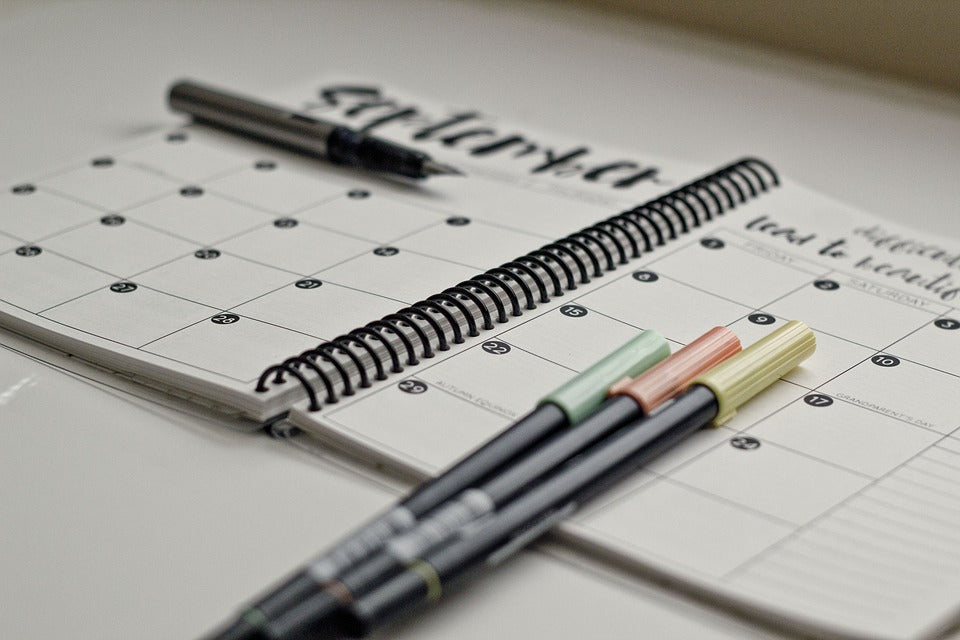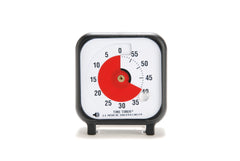Blog — time management tips

How Do New Moms Get Anything Done?
No matter how many books you read or how much advice you get from your mom and friends, nothing can prepare you for the life that comes after the birth of your first child. However, with a little bit of organization, those few first months do not necessarily have to be so harsh on new moms. Whether you’re a working mom or not, your schedule affects the well-being of both you and your child.
Guest Blog: A Tutor's Perspective of the Time Timer
Katya Seberson is a results-oriented SAT and ACT tutor. After struggling through school with dyslexia and a learning disability, Katya taught herself new learning techniques that allowed her to succeed. The company she started, ExecutiveMind, Inc., has helped students commonly gain 190+ on the SAT and 4+ points on the ACT.
By Katya Seberson
As far as we know, human beings are the only mammals who can tell time.
Since the clock has become a permanent fixture our homes ONLY around the 16th century, telling time is a relatively new feature in our evolution, and we (humans) are horrible at time perception. Let me explain.
Time perception is your ability to sense how much time has passed since you started doing something. Let’s say you are writing an essay on a piece of paper (weird, I know), and tell yourself, “let me spend 10 minutes on this paragraph.” How likely is it that you will put your pen down in exactly 10 minutes? Unless you have a clock in sight, there is an almost 100% guarantee you won’t stop after exactly 10 minutes. If you are engaged in a task, you will likely spend more time (time flies when you are having fun), and if you are stuck, you will likely spend less then 10 minutes... “a watched pot never boils.”
We are lousy at telling time because our brain is NOT designed to sense time well. We have areas in our brain dedicated to sight, hearing, smelling, etc. that have been perfected through evolution, but there is NO distinct area in the brain exclusively devoted to sensing time.
What about the biological clock, you ask?
Yes, our biological clock relies on messages from our vital systems to compose a prediction about how much time has passed. Scientists agree that the brain may have several different clocks working together, but independently, the brain selects a “winner” from these different possible timings depending on the context.
Why should I care about telling time if I can always look at the clock?
Developing a good sense of time is a valuable skill in many areas of personal development. Many of you know that the time management industry (teaching people how to manage their schedules) has exploded in the last few years. Many people feel inadequate when they are unable to tell how much time has passed since the meeting, the exam, or the call has started. In my work as a tutor, I see students continuously run out of time on a test as they lack knowing how much time they’ve spent so far on a problem and how much time is left.
The Time Timer has been a magical tool for my students and myself to develop the time perception skill. Because it’s visual, the brain can now lean on the visual cortex (one of the largest areas in the brain) to help itself develop a good sense of how much time has passed and how much time is left. As you are working, the red circle keeps disappearing, letting you know that the time is ticking away, setting the rhythm.
Because the circle is large and very vivid, you can sense how much time is left with your peripheral vision without even looking at the clock directly — no need to stop your task and switch your attention to the clock. I have my Time Timer right next to me as I am typing this article. It shows that I have 15 minutes left of the time I planned to spend on writing this short article for you.
Notice, my eyes are glued to the screen, and I keep my focus on the task, and I am not checking my phone and getting distracted. The Time Timer is a great tool to develop an invaluable sense of time, focus and perfect your time management at work or school.
I have created a video dedicated to using the Pomodoro Method along with The Time Timer. Hope you enjoy it!

Three Top Tips for Making Time in 2019
Certified FocalPoint Business coach Richard Barbercheck shared with us three tips to help you prepare for success in 2019.
Five Tips for Test Prep: Better Managing Time and Sleep for Children with ADHD
While most kids face difficulties preparing for tests at one time or another, children with ADHD can face special challenges routinely. Thankfully, there are many ways you can help your child cope. Try these tips to help improve time management and sleep habits so your youngster can perform her best from Mark Connor, director of DriveSafely.Info, a resource for parents of children with ADHD.


Five Tips to Make Your Family Road Trip Easier...Just in Time for Labor Day Weekend
My family recently traveled out west for 2.5 weeks, enjoying AAA baseball, science and natural history museums, national parks and historic landmarks. We also enjoyed forgetting a sentimental Curious George stuffie in the Mesa Verde National Park lodge (thanks for sending it back, Janice!), complaints about not wanting to look out the window at any more scenery and dodged a few forest fires.
But we did have a great time! And I thought I’d share five things that helped (or would have helped and will help next time) just in time for your Labor Day Weekend travels.

Be More Productive in the New Year with these Five Apps
There are many digital apps to choose from to help us manage our schedules, plans, and tasks, but how do you filter through all of them and find one that works? We reviewed some of the top apps for helping productivity, listed below. All of the apps are also compatible with our Time Timer app ® (more on that later).


Looking for a Life Planner in 2018? Make Sure it Has these Five Essentials
The new year is almost here, and that means it’s time for an updated planner. I live and die by my Google Calendar; in fact, right out of college I moved straight to a Palm Pilot device (it was like an electronic planner that synched with Outlook), and I was smug when a colleague lost her planner and she lost all track of her meetings and appointments.
But the reality is, there’s something about writing down goals, appointments and tasks that helps me filter and prioritize. The essentials will always live on Google, but my planner is the go-to source.

20 Ways to Use the Award-Winning Time Timer 20 MIN
The new Time Timer ® 20 MIN has generated a lot of buzz since its release—it even won a Mom’s Choice Award ®! Parents, teachers, and business professionals are loving this easy-to-read visual timer that keeps everyone on track and on time. Here are 20 ways to use your Time Timer 20 MIN:


8 Ways the Dry Erase Board Gives You a Clean Slate for Productivity in 2017
It’s a new year. The hecticness of the holidays has passed, and it’s time to gear up to meet your objectives in 2017. We’ve got just the tool to help you get started: The Time Timer ® Dry Erase Board. The Dry Erase Board pairs with the Time Timer MOD® and helps you keep your to-do list and urgent tasks on track. A convenient caddy on the back helps you keep supplies like dry erase markers, erasers and other supplies. To help you jumpstart your productivity in 2017, we’re offering a 25% discount off the Dry Erase Board (valid from January 9 - 22, 2017. MOD sold separately). Not sure how to use the Dry Erase Board? Here are 8 top ways customers are using it.
The Dry Erase Board pairs with the Time Timer MOD® and helps you keep your to-do list and urgent tasks on track. A convenient caddy on the back helps you keep supplies like dry erase markers, erasers and other supplies. To help you jumpstart your productivity in 2017, we’re offering a 25% discount off the Dry Erase Board (valid from January 9 - 22, 2017. MOD sold separately). Not sure how to use the Dry Erase Board? Here are 8 top ways customers are using it.

3 Ways to Have More Fun with Less Sugar on Halloween!
 Halloween can be a lot of fun--but oftentimes, it’s also a lot of sugar. Whether you’re worried about the health concerns, or trying to make sure you get enough Reese’s pumpkins for your secret stash above the fridge, limiting your kids’ intake of Halloween candy can help you make Halloween healthier for your kids.
Halloween can be a lot of fun--but oftentimes, it’s also a lot of sugar. Whether you’re worried about the health concerns, or trying to make sure you get enough Reese’s pumpkins for your secret stash above the fridge, limiting your kids’ intake of Halloween candy can help you make Halloween healthier for your kids.
Time Timer ® spoke with Beth Robeson, The Picky Eater Coach, who offers 3 Ways to Have More Fun with Less Sugar this Halloween:
Thank you, MOMCON2016

We recently returned from MOMCON in Milwaukee, where we shared the Time Timer ® with moms from the MOPS (Mothers of Preschoolers) International.
As a family-based company, all of us at Time Timer ® loved being a part of this year’s celebration of inspiration and faith for moms. Before it was a household name, the original Time Timer ® was founded in an everyday household in suburban Cincinnati, Ohio.
Jan Rogers struggled to help her daughter, Loran, keep track of time. She wasn’t old enough to read clocks and often missed the bus. So, mom Jan invented Time Timer, which features a patented red disk that shows elapsed time.

It's Time to Establish a Routine for Preschool Bedtime
If you already have an awesome bedtime routine for your preschooler, congrats! You can skip this article, and just share your tips with us.
For the rest of us, whether it was the start of school for our older kids or a change in sleep habits for our infant, it never hurts to consider a bedtime routine that works to get our preschoolers to sleep on time, and maybe even get time for ourselves.


